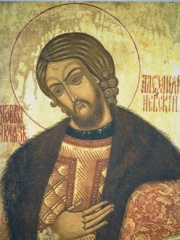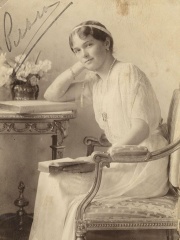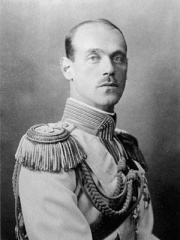







The Most Famous
NOBLEMEN from Russia
Top 10
The following people are considered by Pantheon to be the top 10 most legendary Russian Noblemen of all time. This list of famous Russian Noblemen is sorted by HPI (Historical Popularity Index), a metric that aggregates information on a biography's online popularity. Visit the rankings page to view the entire list of Russian Noblemen.

1. Grand Duchess Anastasia Nikolaevna of Russia (1901 - 1918)
With an HPI of 79.90, Grand Duchess Anastasia Nikolaevna of Russia is the most famous Russian Nobleman. Her biography has been translated into 61 different languages on wikipedia.
Grand Duchess Anastasia Nikolaevna of Russia (Russian: Анастасия Николаевна Романова, romanized: Anastasiya Nikolaevna Romanova; 18 June [O.S. 5 June] 1901 – 17 July 1918) was the youngest daughter of Tsar Nicholas II, the last sovereign of Imperial Russia, and his wife, Tsarina Alexandra Feodorovna. Anastasia was the younger sister of Grand Duchesses Olga, Tatiana, and Maria (commonly known together as the OTMA sisters) and was the elder sister of Alexei Nikolaevich, Tsarevich of Russia. She was murdered with her family by a group of Bolsheviks in Yekaterinburg on 17 July 1918. Persistent rumors of her possible escape circulated after her death, fueled by the fact that the location of her burial was unknown during the decades of communist rule. The abandoned mine serving as a mass grave near Yekaterinburg which held the acidified remains of the Tsar, his wife, and three of their daughters was revealed in 1991. These remains were put to rest at Peter and Paul Fortress in 1998. The bodies of Alexei and the remaining daughter—either Anastasia or her older sister Maria—were discovered in 2007. Her purported survival has been conclusively disproven. Scientific analysis including DNA testing confirmed that the remains are those of the imperial family, showing that Anastasia was killed alongside her family. Several women falsely claimed to have been Anastasia; the best known impostor was Anna Anderson. Anderson's body was cremated upon her death in 1984; DNA testing in 1994 on pieces of Anderson's tissue and hair showed no relation to the Romanov family.

2. Alexander Nevsky (1220 - 1263)
With an HPI of 79.44, Alexander Nevsky is the 2nd most famous Russian Nobleman. His biography has been translated into 73 different languages.
Alexander Yaroslavich Nevsky (Russian: Александр Ярославич Невский; IPA: [ɐlʲɪˈksandr jɪrɐˈsɫavʲɪtɕ ˈnʲɛfskʲɪj] ; monastic name: Aleksiy; 13 May 1221 – 14 November 1263) was Prince of Novgorod (1236–1240; 1241–1256; 1258–1259) and Grand Prince of Vladimir (1252–1263). A grandson of Vsevolod the Big Nest, Nevsky rose to legendary status after victories over Swedish invaders in the Battle of the Neva (1240), which earned him the title "Nevsky" in the 15th century, and over German crusaders in the Battle on the Ice (1242). He agreed to pay tribute to the Golden Horde, which allowed him to preserve the Eastern Orthodox Church, while fighting against foreign powers to the west and the south. Macarius, Metropolitan of Moscow canonized Alexander Nevsky as a saint of the Russian Orthodox Church in 1547. Regarded long after his death as "one of the great heroes of Russian history", Nevsky is credited with having "saved the Russian people [from Catholicism and being] enslaved by the Germans". Nevsky's successes led his image to be used by Peter the Great in the construction of Saint Petersburg. His image was also used to promote patriotism in the Soviet Union, especially during World War II. The 1938 film Alexander Nevsky cemented Nevsky's reputation as a Russian savior. Critics of his legacy argue that the size and importance of his military victories were exaggerated for political purposes, and that he helped ensure the Golden Horde's dominance over Russia.

3. Grand Duchess Olga Nikolaevna of Russia (1895 - 1918)
With an HPI of 79.19, Grand Duchess Olga Nikolaevna of Russia is the 3rd most famous Russian Nobleman. Her biography has been translated into 47 different languages.
Grand Duchess Olga Nikolaevna of Russia (Russian: Ольга Николаевна Романова, romanized: Olga Nikolaevna Romanova; 15 November [O.S. 3 November] 1895 – 17 July 1918) was the eldest child of the last Russian emperor, Nicholas II, and of his wife Alexandra. During her lifetime, Olga's future marriage was the subject of great speculation within Russia. Matches were rumored with Grand Duke Dmitri Pavlovich of Russia, Crown Prince Carol of Romania, Edward, Prince of Wales, eldest son of Britain's George V, and with Crown Prince Alexander of Serbia. Olga herself wanted to marry a Russian and remain in her home country. During World War I, she nursed wounded soldiers in a military hospital until her own nerves gave out and, thereafter, oversaw administrative duties at the hospital. Olga's murder following the Russian Revolution of 1917 resulted in her canonization as a passion bearer by the Russian Orthodox Church. In the 1990s, her remains were identified through DNA testing and were buried in a funeral ceremony at Peter and Paul Cathedral in St. Petersburg, along with those of her parents and two of her sisters.

4. Alexei Nikolaevich, Tsarevich of Russia (1904 - 1918)
With an HPI of 76.39, Alexei Nikolaevich, Tsarevich of Russia is the 4th most famous Russian Nobleman. His biography has been translated into 48 different languages.
Alexei Nikolaevich (Russian: Алексей Николаевич Романов, romanized: Aleksey Nikolaevich Romanov; 12 August [O.S. 30 July] 1904 – 17 July 1918) was the last Russian tsesarevich (heir apparent). He was the youngest child and only son of Tsar Nicholas II and Tsarina Alexandra Feodorovna. He was born with haemophilia, which his parents tried treating with the methods of peasant faith healer Grigori Rasputin. After the February Revolution of 1917, the Romanovs were sent into internal exile in Tobolsk, Siberia. After the October Revolution, the family was initially to be tried in a court of law, before the intensification of the Russian Civil War made execution increasingly favorable in the eyes of the Soviet government. With White Army soldiers rapidly approaching, the Ural Regional Soviet ordered the murder of Alexei, the rest of his family, and four remaining retainers on 17 July 1918. Rumors persisted for decades that Alexei had escaped his execution, with multiple impostors claiming his identity. Alexei's remains, along with those of his sister Maria (or Anastasia), were ultimately discovered in a secondary grave near the rest of the Romanov family in 2007. On 17 July 1998, the 80th anniversary of their execution, Alexei's parents, three of his sisters, and the four retainers, were formally interred in the Cathedral of St. Peter and Paul, while Alexei's and Maria's (or Anastasia's) bones remain in Russian state archives. The Romanov family was canonized as passion bearers by the Russian Orthodox Church in 2000. Alexei is sometimes known to Russian legitimists as Alexei II after his ancestor Alexis of Russia, as until his death they do not recognize the abdication of his father in favor of his uncle Grand Duke Michael as lawful.

5. Olga of Kiev (890 - 969)
With an HPI of 74.64, Olga of Kiev is the 5th most famous Russian Nobleman. Her biography has been translated into 59 different languages.
Olga (Church Slavonic: Ольга; Old Norse: Helga; c. 890–925 – 11 July 969) was a regent of Kievan Rus' for her son Sviatoslav from 945 until 957. Following her baptism, Olga took the name Elenа. She is known for her subjugation of the Drevlians, a tribe that had killed her husband Igor. Even though it was her grandson Vladimir who adopted Christianity and made it the state religion, she was the first ruler to be baptized. Olga is venerated as a saint in the Eastern Orthodox Church with the epithet "Equal to the Apostles". Her feast day is 11 July.

6. Grand Duke Michael Alexandrovich of Russia (1878 - 1918)
With an HPI of 74.17, Grand Duke Michael Alexandrovich of Russia is the 6th most famous Russian Nobleman. His biography has been translated into 43 different languages.
Grand Duke Michael Alexandrovich of Russia (Russian: Михаи́л Алекса́ндрович Романов, romanised: Mikhail Aleksandrovich Romanov; 4 December [O.S. 22 November] 1878 – 13 June 1918) was the youngest son and fifth child of Emperor Alexander III of Russia and youngest brother of Nicholas II. He was designated Emperor of Russia after his brother abdicated in 1917 and proclaimed him "Emperor Michael II", but Michael declined to take power a day later. Michael was born during the reign of his paternal grandfather, Alexander II. He was then fourth in line to the throne after his father and elder brothers Nicholas and George. After the assassination of his grandfather in 1881, he became third in line and, in 1894, after the death of his father, second in line. George died in 1899, leaving Michael as heir presumptive to Nicholas II. The birth of Nicholas's son Alexei in 1904 moved Michael back to second in line, but Alexei was gravely ill with haemophilia and Michael suspected the boy would die, leaving him as heir. Michael caused a commotion at the imperial court when he took Natalia Sergeyevna Wulfert, a married woman, as a lover. Nicholas sent Michael to Orel to avoid scandal but this did not deter Michael, who travelled frequently to see his mistress. After the couple's only child, George, was born in 1910, Michael brought Natalia to Saint Petersburg, where she was shunned by society. In 1912, Michael shocked Nicholas by marrying Natalia in the hope that he would be removed from the line of succession. Michael and Natalia left Russia to live in exile abroad in France, Switzerland and England. After the outbreak of World War I, Michael returned to Russia, assuming command of a cavalry division. When Nicholas abdicated on 15 March [O.S. 2 March] 1917, Michael was named as his successor instead of Alexei. Michael, however, deferred acceptance of the throne until ratification by an elected assembly. He was never confirmed as emperor and, following the Russian Revolution of 1917, he was imprisoned and murdered.

7. Dmitry Donskoy (1350 - 1389)
With an HPI of 73.46, Dmitry Donskoy is the 7th most famous Russian Nobleman. His biography has been translated into 59 different languages.
Dmitry Ivanovich Donskoy (Russian: Дми́трий Ива́нович Донско́й; 12 October 1350 – 19 May 1389) was Prince of Moscow from 1359 and Grand Prince of Vladimir from 1363 until his death. He was the heir of Ivan II. He was the first prince of Moscow to openly challenge Mongol authority in Russia. In traditional Russian historiography, he is regarded as a Russian national hero and a central figure of the Russian Middle Ages. His nickname, Donskoy ("of the Don"), alludes to his great victory against the Tatars in the Battle of Kulikovo (1380), which took place on the Don River. He is venerated as a saint in the Orthodox Church with his feast day on 19 May.

8. Grand Duchess Olga Alexandrovna of Russia (1882 - 1960)
With an HPI of 71.52, Grand Duchess Olga Alexandrovna of Russia is the 8th most famous Russian Nobleman. Her biography has been translated into 35 different languages.
Grand Duchess Olga Alexandrovna of Russia (Russian: Ольга Александровна Романова, romanized: Olga Aleksandrovna Romanova; 13 June [O.S. 1 June] 1882 – 24 November 1960) was the youngest child of Emperor Alexander III of Russia and younger sister of Emperor Nicholas II. Olga was raised at the Gatchina Palace outside Saint Petersburg. Olga's relationship with her mother, Empress Marie, the daughter of King Christian IX of Denmark, was strained and distant from childhood. In contrast, she and her father were close. He died when she was 12, and her brother Nicholas became emperor. In 1901, at 19, she married Duke Peter Alexandrovich of Oldenburg, who was privately believed by family and friends to be homosexual. Their marriage of 15 years remained unconsummated, and Peter at first refused Olga's request for a divorce. The couple led separate lives and their marriage was eventually annulled by the Emperor in October 1916. The following month Olga married cavalry officer Nikolai Kulikovsky, with whom she had fallen in love several years before. During the First World War, Olga served as an army nurse and was awarded a medal for personal gallantry. At the downfall of the Romanovs in the Russian Revolution of 1917, she fled with her husband and children to Crimea, where they lived under the threat of assassination. Her brother Nicholas and his family were shot and bayoneted to death by revolutionaries. Olga escaped revolutionary Russia with her second husband and their two sons in February 1920. They joined her mother, the Dowager Empress, in Denmark. In exile, Olga acted as companion and secretary to her mother and was often sought out by Romanov impostors who claimed to be her dead relatives. She met Anna Anderson, the best-known impostor, in Berlin in 1925. After the Dowager Empress's death in 1928, Olga and her husband purchased a dairy farm in Ballerup, near Copenhagen. She led a simple life: raising her two sons, working on the farm and painting. During her lifetime, she painted over 2,000 works of art, which provided extra income for both her family and the charitable causes she supported. In 1948, feeling threatened by Joseph Stalin's regime, Olga and her immediate family relocated to a farm in Campbellville, Ontario, Canada. With advancing age, Olga and her husband moved to a bungalow near Cooksville, Ontario. Colonel Kulikovsky died there in 1958. Two years later, as her health deteriorated, Olga moved with friends to a small apartment in East Toronto. She died aged 78, seven months after her older sister, Xenia. At the end of her life and afterwards, Olga was widely labelled the last Grand Duchess of Imperial Russia.

9. Grand Duchess Maria Alexandrovna of Russia (1853 - 1920)
With an HPI of 70.77, Grand Duchess Maria Alexandrovna of Russia is the 9th most famous Russian Nobleman. Her biography has been translated into 36 different languages.
Grand Duchess Maria Alexandrovna of Russia (Russian: Мария Александровна, romanized: Mariya Aleksandrovna; 17 October [O.S. 5 October] 1853 – 22 October 1920) was the sixth child and only surviving daughter of Alexander II of Russia and Marie of Hesse and by Rhine; she was Duchess of Edinburgh and later Duchess of Saxe-Coburg and Gotha as the wife of Alfred, Duke of Saxe-Coburg and Gotha. She was the younger sister of Alexander III of Russia and the paternal aunt of Russia's last emperor, Nicholas II. In 1874, Maria married Prince Alfred, Duke of Edinburgh, the second son of Queen Victoria and Prince Albert of Saxe-Coburg and Gotha; she was the only Romanov to marry into the British royal family. The couple had five children: Alfred, Marie, Victoria Melita, Alexandra, and Beatrice. For the first years of her marriage, Maria lived in England. She neither adapted to the British court nor overcame her dislike for her adopted country. She accompanied her husband on his postings as an admiral of the Royal Navy at Malta (1886–1889) and Devonport (1890–1893). The Duchess of Edinburgh travelled extensively through Europe. She visited her family in Russia frequently and stayed for long periods in England and Germany attending social and family events. In August 1893, Maria became Duchess of Saxe-Coburg and Gotha when her husband inherited the duchy on the death of his childless uncle, Ernest II, Duke of Saxe-Coburg and Gotha. She enjoyed life in Germany, where she became active in cultural endeavours and charitable work. To her daughters, she gave every support, but she was critical of her wayward son, Alfred, who died in 1899. Her husband died in 1900 and was succeeded as Duke of Saxe-Coburg and Gotha by his nephew Charles Edward. In her widowhood, Maria continued to live in Coburg. The outbreak of World War I divided her sympathies. She sided with Germany against her native Russia. Many of her relatives, including her brother Paul and her nephew Nicholas II, were killed during the Russian Revolution, and Maria lost her considerable fortune. After World War I, the Duchy of Saxe-Coburg and Gotha ceased to exist in November 1918. Maria died in 1920 while living under reduced circumstances in exile in Switzerland.

10. Daniel of Moscow (1261 - 1303)
With an HPI of 70.08, Daniel of Moscow is the 10th most famous Russian Nobleman. His biography has been translated into 43 different languages.
Daniil Aleksandrovich (Russian: Даниил Александрович; 1261 – 5 March 1303), also known as Daniil of Moscow, was the youngest son of Alexander Nevsky and forefather of all Princes of Moscow. His descendants are known as the Daniilovichi. He has been locally approved for veneration in the Russian Orthodox Church, with feast days on March 17 and September 12.
People
Pantheon has 37 people classified as Russian noblemen born between 890 and 1906. Of these 37, none of them are still alive today. The most famous deceased Russian noblemen include Grand Duchess Anastasia Nikolaevna of Russia, Alexander Nevsky, and Grand Duchess Olga Nikolaevna of Russia.
Deceased Russian Noblemen
Go to all RankingsGrand Duchess Anastasia Nikolaevna of Russia
1901 - 1918
HPI: 79.90
Alexander Nevsky
1220 - 1263
HPI: 79.44
Grand Duchess Olga Nikolaevna of Russia
1895 - 1918
HPI: 79.19
Alexei Nikolaevich, Tsarevich of Russia
1904 - 1918
HPI: 76.39
Olga of Kiev
890 - 969
HPI: 74.64
Grand Duke Michael Alexandrovich of Russia
1878 - 1918
HPI: 74.17
Dmitry Donskoy
1350 - 1389
HPI: 73.46
Grand Duchess Olga Alexandrovna of Russia
1882 - 1960
HPI: 71.52
Grand Duchess Maria Alexandrovna of Russia
1853 - 1920
HPI: 70.77
Daniel of Moscow
1261 - 1303
HPI: 70.08
Grand Duke Sergei Alexandrovich of Russia
1857 - 1905
HPI: 69.96
Grand Duchess Maria Pavlovna of Russia
1890 - 1958
HPI: 69.75
Overlapping Lives
Which Noblemen were alive at the same time? This visualization shows the lifespans of the 24 most globally memorable Noblemen since 1700.



